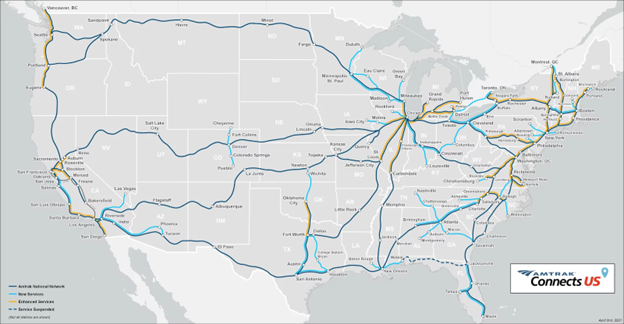Big Picture
In many areas of the U.S., there are opportunities to meaningfully invest in new railway infrastructure that would improve the lives of millions of people and contribute to a more efficient, cost-effective and environmentally friendly means of transportation. These resulting benefits are especially true for cities where population density combined with outdated infrastructure causes problems for people and businesses alike. To bring cities into a new era and spread out the population, the U.S. must incentivize the creation of new commercial and passenger rail networks.

Graphic From: “Amtrak’s Vision for Improving Transportation Across America.” Amtrak. Amtrak.com. June 2021. https://www.amtrak.com/content/dam/projects/dotcom/english/public/documents/corporate/reports/Amtrak-2021-Corridor-Vision-060121.pdf. This figure illustrates Amtrak’s, in coordination with states, existing and planned rail lines connecting most major U.S. cities. While this plan is not yet final, it represents a significant expansion of Amtrak lines.
Operative Definitions
Environmental Protection Agency (EPA): An agency within the U.S. Federal Government that is tasked with environmental protection concerns.
Public-private partnership (PPP): A specific type of project funding model between the public and private sector used to finance, construct and eventually operate components of infrastructure such as bridges, buildings or communications systems. It provides a specific focus point for projects and may help ensure minimal progression delays.
Important Facts and Statistics
According to the EPA, freight railroad activity accounts for only 0.5% of total U.S. greenhouse emissions despite accounting for 40% of U.S. long-distance hauling.
American Class I railroads provide $71 billion in wages, support 1.1 million jobs and sustain $219.5 billion in economic output.
According to a report by the United States Census Bureau, the average American daily spends 27.6 minutes in a one-way commute and almost an hour total commute for work.
Five-Point Plan
1) Appoint Amtrak as the primary passenger rail operator.
Amtrak already provides leadership and organization to the national railway system. If made the primary operator, Amtrak would also use existing data to determine which routes would be most efficient, cost-effective and realistic. These determinations would consider the potential fares needed to sustain future operations.
2) Support and pass the Intercity Passenger Rail Trust Fund Act (S.899).
S.899 would establish a dedicated U.S. Treasury program for passenger rail systems using federal funding. This act would ensure a streamlined and predictable funding structure for projects that will require extraordinary amounts of effort for future construction and maintenance.
3) Partner with existing rail operators.
Most passenger rails operate using privately owned railroad tracks. Partnering with existing rail operators would ensure smooth integration and efficient operability of new routes. New track development, especially for passenger lines, would be ideal in some congested areas.
4) Conduct a thorough review of existing infrastructure development regulations.
Overregulation presents a serious burden to overcome for any amount of infrastructure development in many areas. A balance between the need to maintain environmental standards and ensure the development of public services, such as railways, must be pursued. Streamlining certain reviews, specifically those of local and state, like environmental reviews, can help push along new projects without causing undue delays.
5) Ensure passenger preference on specific lines.
Without prioritizing passenger tracks, conflicts between host rail and passenger rail priorities are a significant issue. According to Amtrak, these conflicts have caused one million minutes in delays in 2019. Enforcing by law designated tracks with passenger priority will promote trust in the reliability of these networks, especially for paying commuters.
Why This Initiative is Important
Establishing efficient, safe and environmentally friendly means of transportation for both goods and passengers should be considered a top priority. For commuters, an alternative to overcrowded highways would improve job accessibility, reduce travel times and drastically decrease vehicle emissions. Furthermore, rail systems provide a cost-effective and environmentally friendly method of transporting goods over long distances and to areas of high demand. Lastly, the rail industry, which includes both passenger and freight, is a significant source of quality jobs for all areas in which the industry resides.
Acknowledgments: The opinions expressed in this proposal are those of the individual author.
The following student(s) worked on this nonpartisan proposal: Matthew Reyna, University of California, Irvine graduate.
Sources
“Amtrak’s Vision for Improving Transportation Across America.” Amtrak. Amtrak.com. June 2021. https://www.amtrak.com/content/dam/projects/dotcom/english/public/documents/corporate/reports/Amtrak-2021-Corridor-Vision-060121.pdf
“Census Bureau Estimates Shows Average One-Way Travel Time to Work Rises to All-Time High.” United States Census Bureau. 18 Mar. 2021. https://www.census.gov/newsroom/press-releases/2021/one-way-travel-time-to-work-rises.html
“Freight Rail Facts & Figures.” Association of American Railroads. May 2022. https://www.aar.org/facts-figures
Irani, Daraius, et al. “Economic and Fiscal Impact Analysis of Class I Railroads in 2017.” Regional Economic Studies Institute. 22 Oct. 2018. https://www.aar.org/wp-content/uploads/2018/11/AAR-Class-I-Railroad-Towson-Economic-Impact-October-2018.pdf




Kommentare